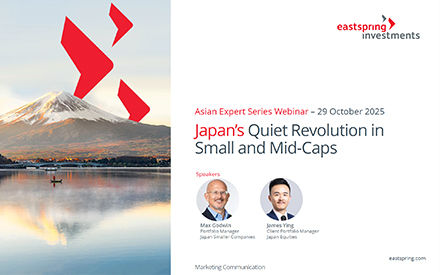Summary
The collapse of SVB should have limited implications for Asia, although it could influence the Fed’s rate decision in March. It also highlights the risk that the Fed’s rate hiking cycle would ultimately surface fragilities within the global economy, reinforcing our investment teams’ continued focus on quality profits and cashflows.
The collapse of Silicon Valley Bank (SVB), a leading lender for the tech start-up community in the US, and the subsequent closure of New York-based Signature bank have caused a sharp sell-off among the US regional banking stocks. US and European global banks were also affected, albeit to a more limited extent. With SVB’s woes stemming from a USD1.8 bn loss on the sale of a portfolio of securities, investor concerns have risen over the value of banks’ bond portfolios. The impact on Asian markets has been relatively muted.
Implications:
US banking system. The systemic threat to the US banking system should be limited. The US regulators have responded swiftly to prevent any contagion risks to the US financial system:
The issue with Mark to Market for the held to maturity assets is a liquidity problem, not a solvency one. This mechanism immediately reduces the risk of a bank run where the Federal Reserve Banks are in effect backstopping all deposits in the US banking system by ensuring the liquidity problem is solved.
Furthermore, US banks that have been identified as systemically important financial institutions (SIFIs) have formidable capital buffers. These buffers have shielded them from the declines in the value of their held-to-maturity securities portfolios which have already been reflected on their balance sheets at the end of 2022.
Fed rate decision. The recent market developments have lowered the likelihood of a 50bp rate hike at the 21-22 March FOMC meeting. We believe that the odds are now split between a 25bp hike or a temporary pause. That said, barring any systemic contagion, jobs and inflation data will continue to dominate the Fed’s interest rate decision over the longer term.
Asian banks. It was reported that due to weak loan demand, SVB’s investment portfolio made up 57% of its total assets, a level that was significantly higher than other major US banks. This made it particularly vulnerable to a fall in the value of its securities’ portfolio. With the 20 largest banks in Asia Pacific having an average loan to deposit ratio of 75%1, securities should make up a much smaller share of assets.
Asian tech sector. While there has been some knock-on impact on the US tech sector, the impact on the listed Asian tech sector is likely to be far more modest given the limited reliance on SVB for funding.
We believe that this is a short-term market event which is unlikely to impact our long-term investment process. It should be expected that the Fed’s rate hiking cycle, which started about a year ago, would surface fragilities within the global economy. We had highlighted this risk in our 2023 Market Outlook and our investment teams continue to focus on companies and sectors that produce strong cashflows.
Sources:
1As of 30 June 2022. Sample limited to the 20 largest Asia-Pacific banks in S&P Global Market Intelligence by total assets as of 30 June 2022. Loans/deposits ratio is calculated using total net loans and total deposits.
The information and views expressed herein do not constitute an offer or solicitation to deal in shares of any securities or financial instruments and it is not intended for distribution or use by anyone or entity located in any jurisdiction where such distribution would be unlawful or prohibited. The information does not constitute investment advice or an offer to provide investment advisory or investment management service or the solicitation of an offer to provide investment advisory or investment management services in any jurisdiction in which an offer or solicitation would be unlawful under the securities laws of that jurisdiction.
Past performance and the predictions, projections, or forecasts on the economy, securities markets or the economic trends of the markets are not necessarily indicative of the future or likely performance of Eastspring Investments or any of the strategies managed by Eastspring Investments. An investment is subject to investment risks, including the possible loss of the principal amount invested. Where an investment is denominated in another currency, exchange rates may have an adverse effect on the value price or income of that investment. Furthermore, exposure to a single country market, specific portfolio composition or management techniques may potentially increase volatility.
Any securities mentioned are included for illustration purposes only. It should not be considered a recommendation to purchase or sell such securities. There is no assurance that any security discussed herein will remain in the portfolio at the time you receive this document or that security sold has not been repurchased.
The information provided herein is believed to be reliable at time of publication and based on matters as they exist as of the date of preparation of this report and not as of any future date. Eastspring Investments undertakes no (and disclaims any) obligation to update, modify or amend this document or to otherwise notify you in the event that any matter stated in the materials, or any opinion, projection, forecast or estimate set forth in the document, changes or subsequently becomes inaccurate. Eastspring Investments personnel may develop views and opinions that are not stated in the materials or that are contrary to the views and opinions stated in the materials at any time and from time to time as the result of a negative factor that comes to its attention in respect to an investment or for any other reason or for no reason. Eastspring Investments shall not and shall have no duty to notify you of any such views and opinions. This document is solely for information and does not have any regard to the specific investment objectives, financial or tax situation and the particular needs of any specific person who may receive this document.
Eastspring Investments Inc. (Eastspring US) primary activity is to provide certain marketing, sales servicing, and client support in the US on behalf of Eastspring Investment (Singapore) Limited (“Eastspring Singapore”). Eastspring Singapore is an affiliated investment management entity that is domiciled and registered under, among other regulatory bodies, the Monetary Authority of Singapore (MAS). Eastspring Singapore and Eastspring US are both registered with the US Securities and Exchange Commission as a registered investment adviser. Registration as an adviser does not imply a level of skill or training. Eastspring US seeks to identify and introduce to Eastspring Singapore potential institutional client prospects. Such prospects, once introduced, would contract directly with Eastspring Singapore for any investment management or advisory services. Additional information about Eastspring Singapore and Eastspring US is also is available on the SEC’s website at www.adviserinfo.sec. gov.
Certain information contained herein constitutes "forward-looking statements", which can be identified by the use of forward-looking terminology such as "may", "will", "should", "expect", "anticipate", "project", "estimate", "intend", "continue" or "believe" or the negatives thereof, other variations thereof or comparable terminology. Such information is based on expectations, estimates and projections (and assumptions underlying such information) and cannot be relied upon as a guarantee of future performance. Due to various risks and uncertainties, actual events or results, or the actual performance of any fund may differ materially from those reflected or contemplated in such forward-looking statements.
Eastspring Investments companies (excluding JV companies) are ultimately wholly-owned / indirect subsidiaries / associate of Prudential plc of the United Kingdom. Eastspring Investments companies (including JV’s) and Prudential plc are not affiliated in any manner with Prudential Financial, Inc., a company whose principal place of business is in the United States of America.














